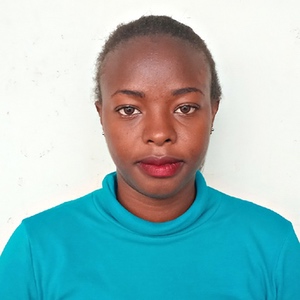December, 2019: Ematiha Secondary School Project Complete!
Ematiha Secondary School in Kenya now has access to a new source of safe, clean water thanks to the completion of their rain tank, which has the ability to collect 50,000 liters of water. We installed new latrines for students, handwashing stations, and we trained students and staff on improved sanitation and hygiene practices. All of these components work together to unlock the opportunity for these students to live better, healthier lives.

Student at the rain tank's tap
Rain Tank
Construction for this 50,000-liter rain tank was successful!
Parents, staff, and students helped our artisans gather everything needed for construction. All the while, the school cooks prepared meals for the artisans, and the school provided accommodations for the artisans during their work. Local women and men helped our artisans with their manual labor, too.
The process officially began with our staff and school administration looking around the school compound to try and determine the best location for a new rain tank. This needed to be the best site with good, clean roofing to catch the rainwater.

Adding stones to the rain tank foundation
Then, we cleared the site: excavating the soil within the required measurements to make level ground for the tank foundation. The foundation was cast by laying hardcore on level ground and then reinforcing it using steel, concrete and waterproof cement.

Positioning the wire over the concrete foundation
Both the drawing pipe as well as the washout pipe were affixed as the foundation was laid. The wall was built with ferro-cement techniques through 6 layers. The inner wall was plastered while rough casting was done on the outer part. Finally, the catchment area was dug, plastered, and a staircase installed.

Passing materials to the inside of the tank
Dome construction could begin after the superstructure had been given enough time to settle. The manhole cover was fitted, inlet pipes were connected to the roof gutters, inlet screens, ventilation pipes (breathers) and overflow pipes were all done to standard.

Working on the tap access area
Being the rainy season, the only challenges during the entire construction process were having to pause work, especially in the afternoons, due to the heavy downpours that could wash away the plaster and cement if it had not dried long enough yet.

Inscribing the rain tank
Once finished, the tank was given 3 to 4 weeks to undergo complete curing before it was cleaned and handed over to Ematiha Secondary School, though we will continue to offer them unmatchable support as a part of our monitoring and maintenance program.
The celebration was a great chance for us to acknowledge the school administration and students as the primary parties entrusted with the tools we’ve given, as well as remind them of our continued support as they develop.

"I had an opportunity to work as an unskilled laborer during the construction of this tank and I know the effort the donors, implementing partner, and the school has put in place to ensure that the project is successful. For as long as I am in this school, I will make sure that this tank is well taken care of and if anyone is found tampering with it [they] should be punished thoroughly. We are now assured of adequate, clean, and safe water in school for drinking and for general use," said student David Anzala.

VIP Latrines
This project funded the installation of 6 new ventilated improved pit (VIP) latrines, half for girls and half for boys.

Girls pose with their new latrines
All of these new latrines have cement floors that are designed to be easy to use and clean. And with a rain tank right on school property, there should be enough water to keep them clean.

Boys peering out from their new latrines
Handwashing Stations
The 2 handwashing stations were delivered to the school and handed over to the student health club. These were placed outside of the girls’ and boys’ latrines to encourage handwashing after latrine use.
Health club members teach other students how to properly wash their hands at the stations, make sure the stations are filled with water and work to ensure that there is always soap or ash available.
New Knowledge
Hygiene and sanitation training was scheduled with the help of the school principal Mr. David Ambani and teacher Mr. Thomas Aura, who together ensured that the training date would be convenient for students, staff, and parent representatives. Individual teachers helped by selecting students from each class to represent the others.
18 students attended training, which was a good turnout considering the students were already on break. The weather was conducive for the training as it was sunny, therefore we preferred to conduct the training under trees that are situated in the school compound. The place was quiet and calm and the training went on well without any interruptions. The participants were attentive throughout the training and they asked many questions after each topic. They were also ready to participate in the demonstrations when asked to by the trainers.

Training begins
We covered a number of topics, including personal hygiene such as bathing, oral hygiene, and handwashing with soap as a barrier from germs; and operation and maintenance of the new facilities, with each person understanding their role for long-lasting clean water and good health. The new student health club will be greatly involved in project management and will be responsible for encouraging good health and hygiene practices amongst their peers, teachers, and the larger community.

Dental hygiene training
Under the topic of hygiene promotion, dental hygiene was discussed exhaustively. The participants were taught how to brush their teeth in the right way and they were advised to replace their toothbrushes after 3 months. They were also advised to use ash, salt, or charcoal in the absence of toothpaste. The students were very interested in this topic, making the conversation special.

Student demonstrates handwashing to her peers
The participants were also eager to practice the best way to wash their hands and they were glad that they now have their own handwashing stations to wash their hands. Before there was only 1 handwashing station that served teachers, but students wished to wash their hands too. They could only wash their hands at the plastic tank if water was available. Now, boys and girls each have their own dedicated handwashing station outside their latrines, which they will be responsible for filling with water. Given their enthusiasm for this topic, we think they will be sure to follow through in their responsibilities.

"When I was informed that I needed to be in school to attend a training [during break], I almost refused to come thinking that it was a trick for us to come to school and harvest maize from the school farm. I am glad I came because I have acquired new information about proper sanitation and improved hygiene practices. This information will change the behavior of our school positively and also improve our well being," said Rabecca Shisia, a 16-year-old student.
Thank you for making all of this possible!


 Rainwater Catchment
Rainwater Catchment
 Rehabilitation Project
Rehabilitation Project




































